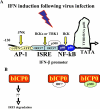Regulation of Innate Immune Responses by Bovine Herpesvirus 1 and Infected Cell Protein 0 (bICP0)
- PMID: 21994549
- PMCID: PMC3185490
- DOI: 10.3390/v1020255
Regulation of Innate Immune Responses by Bovine Herpesvirus 1 and Infected Cell Protein 0 (bICP0)
Abstract
Bovine herpesvirus 1 (BoHV-1) infected cell protein 0 (bICP0) is an important transcriptional regulatory protein that stimulates productive infection. In transient transfection assays, bICP0 also inhibits interferon dependent transcription. bICP0 can induce degradation of interferon stimulatory factor 3 (IRF3), a cellular transcription factor that is crucial for activating beta interferon (IFN-β) promoter activity. Recent studies also concluded that interactions between bICP0 and IRF7 inhibit trans-activation of IFN-β promoter activity. The C3HC4 zinc RING (really important new gene) finger located near the amino terminus of bICP0 is important for all known functions of bICP0. A recombinant virus that contains a single amino acid change in a well conserved cysteine residue of the C3HC4 zinc RING finger of bICP0 grows poorly in cultured cells, and does not reactivate from latency in cattle confirming that the C3HC4 zinc RING finger is crucial for viral growth and pathogenesis. A bICP0 deletion mutant does not induce plaques in permissive cells, but induces autophagy in a cell type dependent manner. In summary, the ability of bICP0 to stimulate productive infection, and repress IFN dependent transcription plays a crucial role in the BoHV-1 infection cycle.
Keywords: IRF3; IRF7; bICP0; bovine herpesvirus 1 (BoHV-1); interferon; transcriptional regulation.
Figures



Similar articles
-
The infected cell protein 0 encoded by bovine herpesvirus 1 (bICP0) induces degradation of interferon response factor 3 and, consequently, inhibits beta interferon promoter activity.J Virol. 2007 Apr;81(7):3077-86. doi: 10.1128/JVI.02064-06. Epub 2007 Jan 10. J Virol. 2007. PMID: 17215277 Free PMC article.
-
The zinc RING finger of bovine herpesvirus 1-encoded bICP0 protein is crucial for viral replication and virulence.J Virol. 2008 Dec;82(24):12060-8. doi: 10.1128/JVI.01348-08. Epub 2008 Oct 8. J Virol. 2008. PMID: 18842710 Free PMC article.
-
Cytoplasmic localized infected cell protein 0 (bICP0) encoded by bovine herpesvirus 1 inhibits β interferon promoter activity and reduces IRF3 (interferon response factor 3) protein levels.Virus Res. 2011 Sep;160(1-2):143-9. doi: 10.1016/j.virusres.2011.06.003. Epub 2011 Jun 12. Virus Res. 2011. PMID: 21689696 Free PMC article.
-
Bovine Herpesvirus 1 Counteracts Immune Responses and Immune-Surveillance to Enhance Pathogenesis and Virus Transmission.Front Immunol. 2019 May 7;10:1008. doi: 10.3389/fimmu.2019.01008. eCollection 2019. Front Immunol. 2019. PMID: 31134079 Free PMC article. Review.
-
A review of the biology of bovine herpesvirus type 1 (BHV-1), its role as a cofactor in the bovine respiratory disease complex and development of improved vaccines.Anim Health Res Rev. 2007 Dec;8(2):187-205. doi: 10.1017/S146625230700134X. Anim Health Res Rev. 2007. PMID: 18218160 Review.
Cited by
-
A protein (ORF2) encoded by the latency-related gene of bovine herpesvirus 1 interacts with DNA.J Virol. 2013 May;87(10):5493-501. doi: 10.1128/JVI.00193-13. Epub 2013 Mar 6. J Virol. 2013. PMID: 23468493 Free PMC article.
-
Bovine Herpes Virus 1 (BHV-1) and Herpes Simplex Virus Type 1 (HSV-1) Promote Survival of Latently Infected Sensory Neurons, in Part by Inhibiting Apoptosis.J Cell Death. 2013 Apr 9;6:1-16. doi: 10.4137/JCD.S10803. eCollection 2013. J Cell Death. 2013. PMID: 25278776 Free PMC article. Review.
-
BHV-1 induced oxidative stress contributes to mitochondrial dysfunction in MDBK cells.Vet Res. 2016 Mar 22;47:47. doi: 10.1186/s13567-016-0332-2. Vet Res. 2016. PMID: 27000063 Free PMC article.
-
A protein (ORF2) encoded by the latency-related gene of bovine herpesvirus 1 interacts with Notch1 and Notch3.J Virol. 2011 Mar;85(6):2536-46. doi: 10.1128/JVI.01937-10. Epub 2010 Dec 29. J Virol. 2011. PMID: 21191019 Free PMC article.
-
The β-catenin signaling pathway stimulates bovine herpesvirus 1 productive infection.Virology. 2017 Jan;500:91-95. doi: 10.1016/j.virol.2016.10.014. Epub 2016 Oct 24. Virology. 2017. PMID: 27788397 Free PMC article.
References
-
- 1995–96 Agricultural Statistics. National Agricultural Statistics Service (NASS), Agricultural Statistics Board, U.S. Department of Agriculture; 1996.
-
- Aaronson DS, Horvath CM. A road map for those who don't know JAK-STAT. Science. 2002;296:1653–1655. - PubMed
-
- Aderem A, Hume DA. How do you see CG. Cell. 2000;103:993–996. - PubMed
Grants and funding
LinkOut - more resources
Full Text Sources
Other Literature Sources

